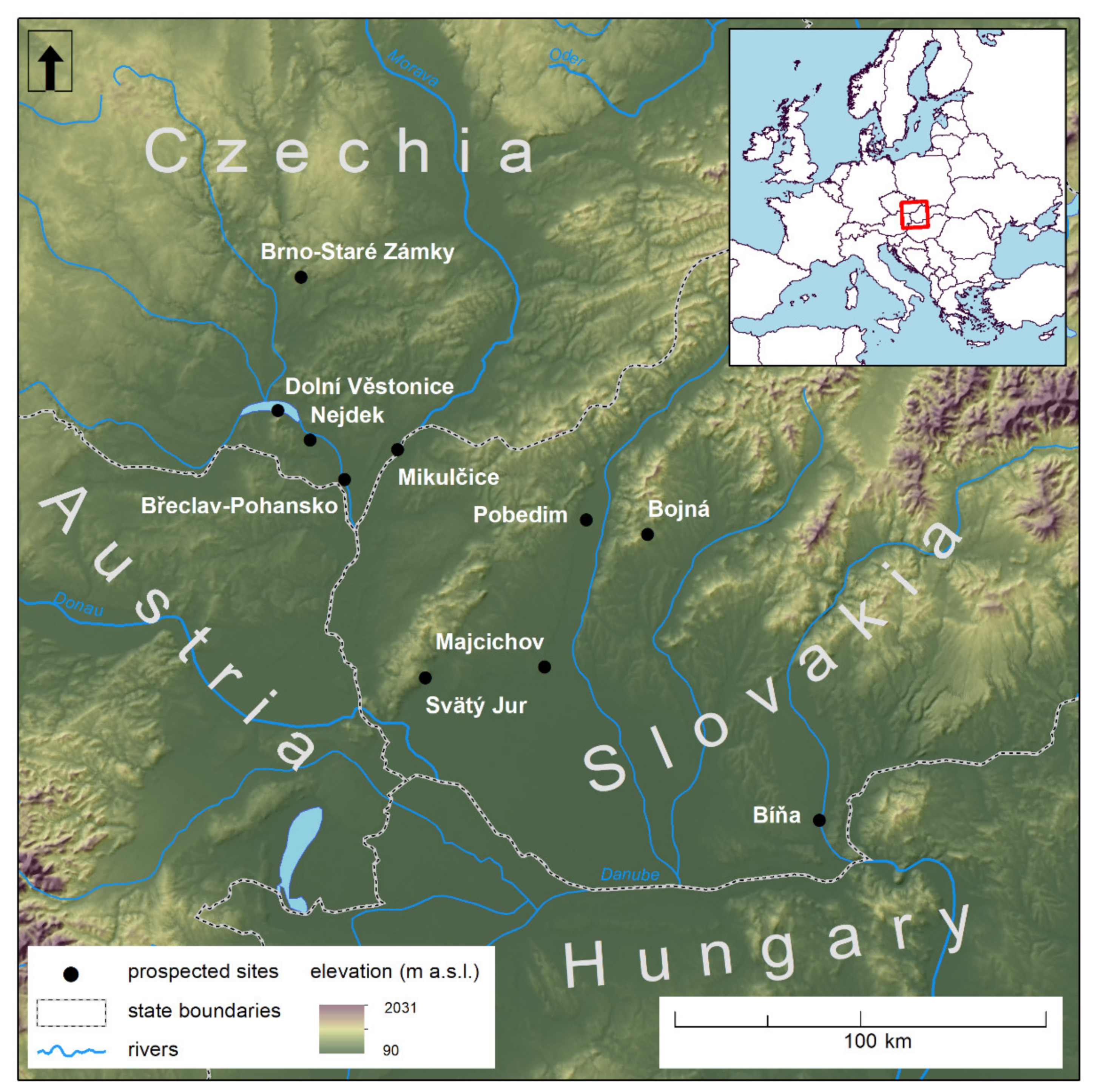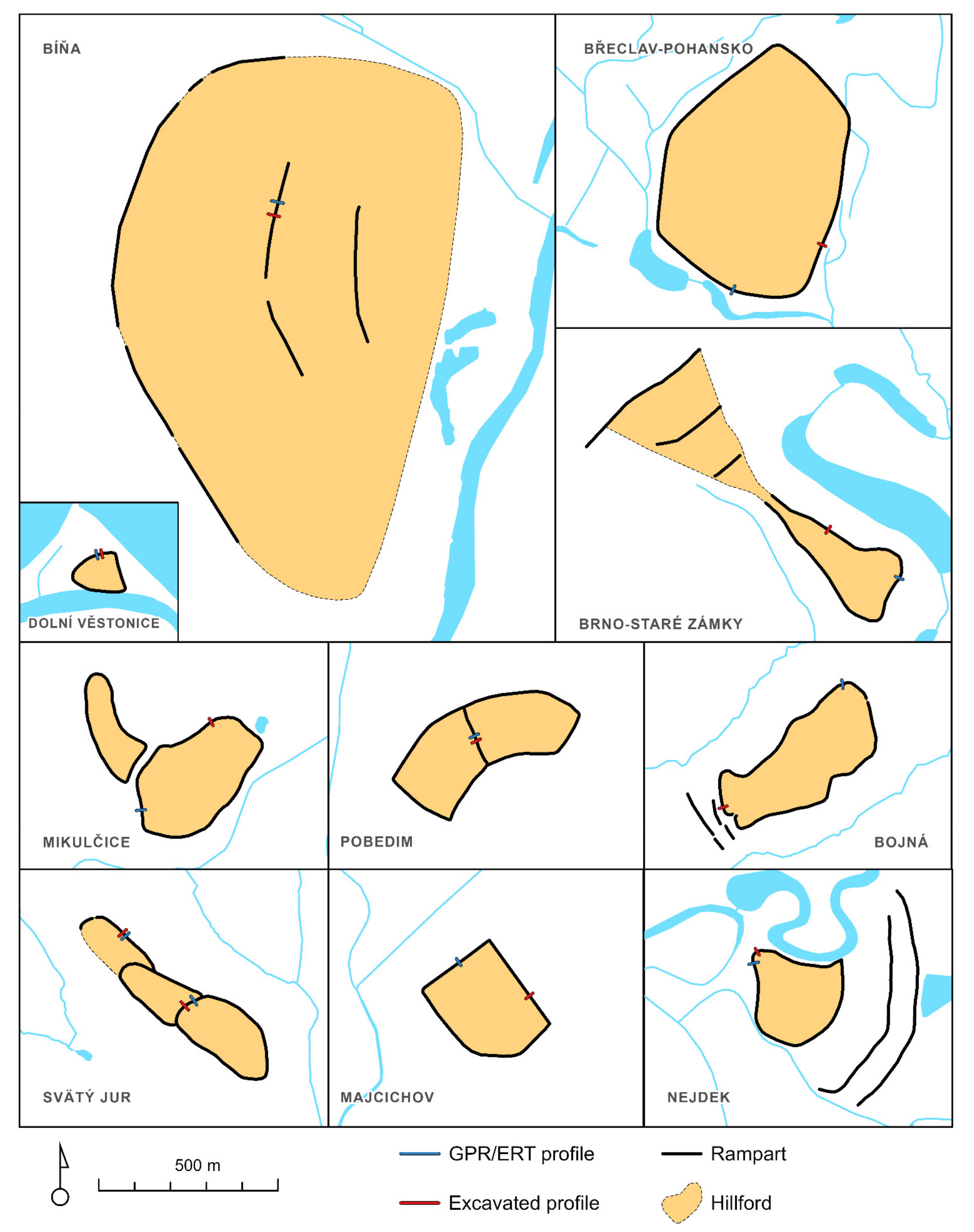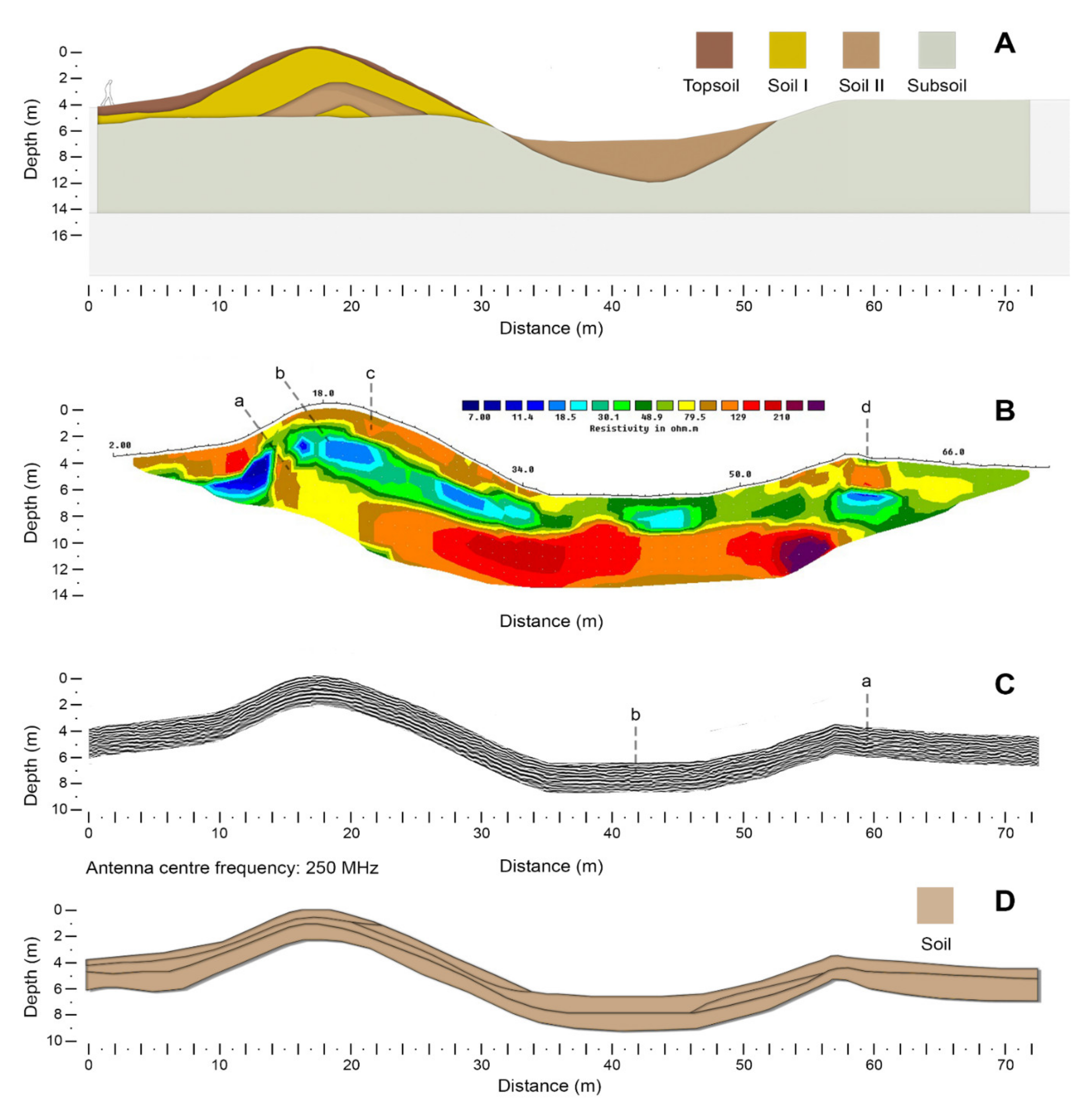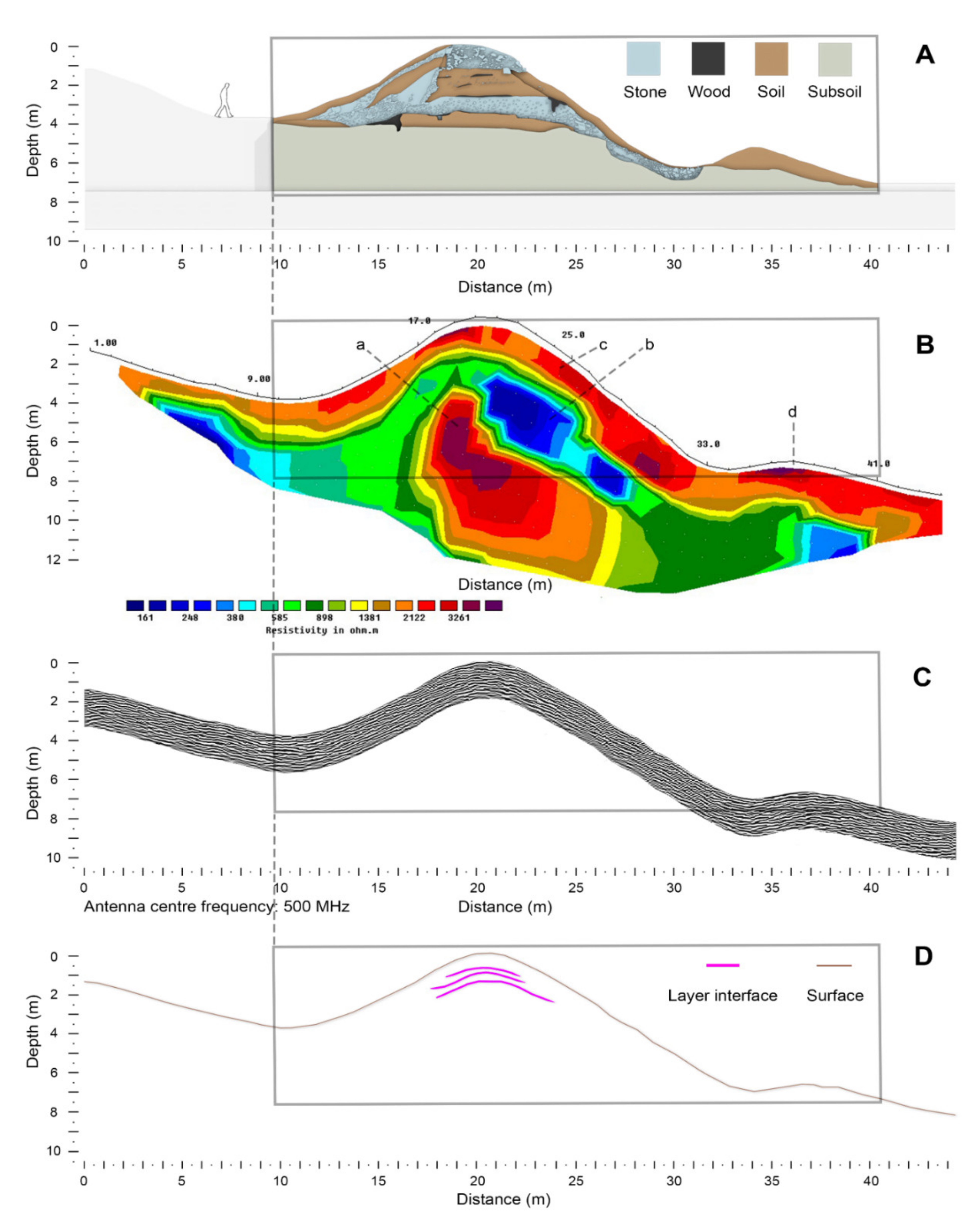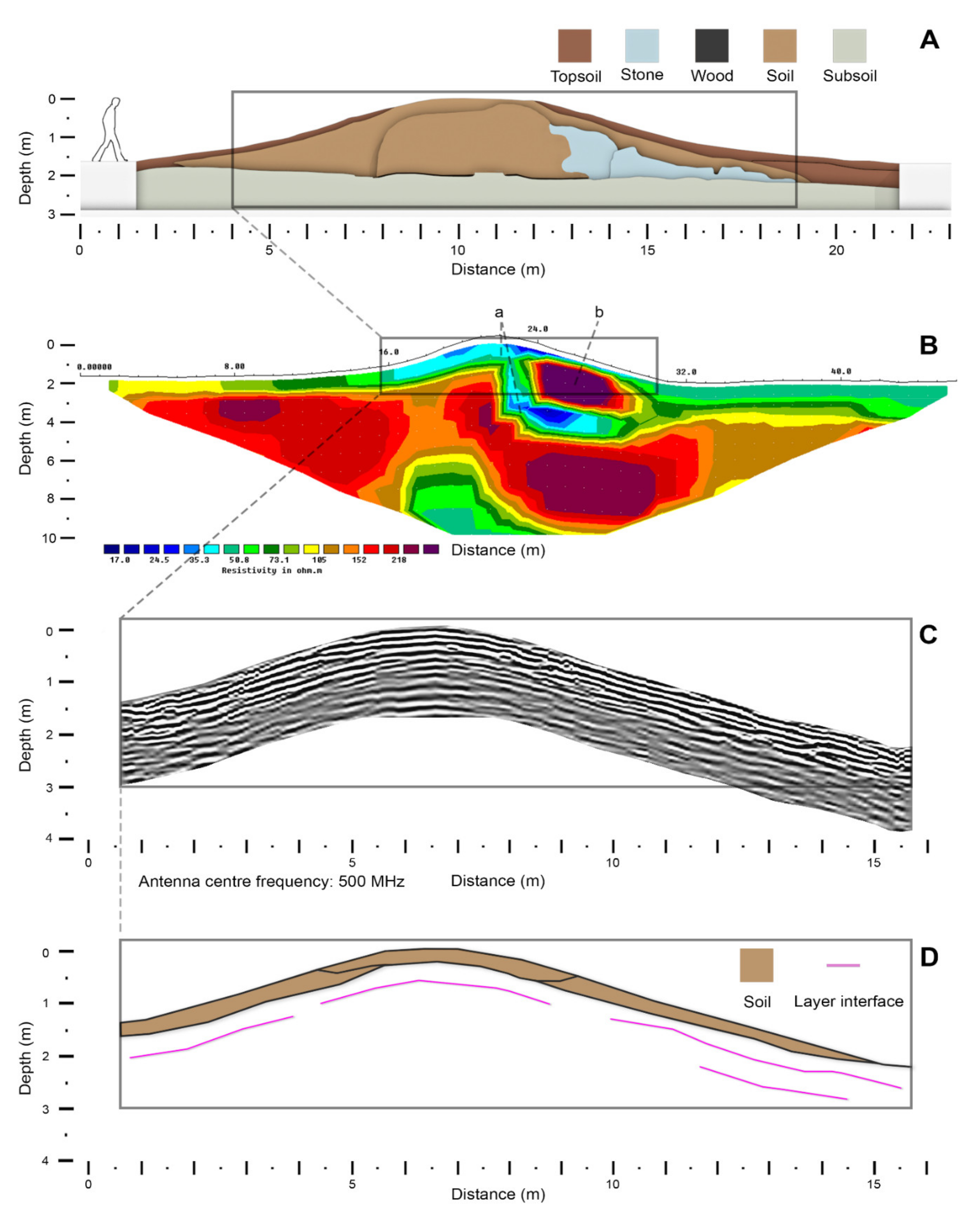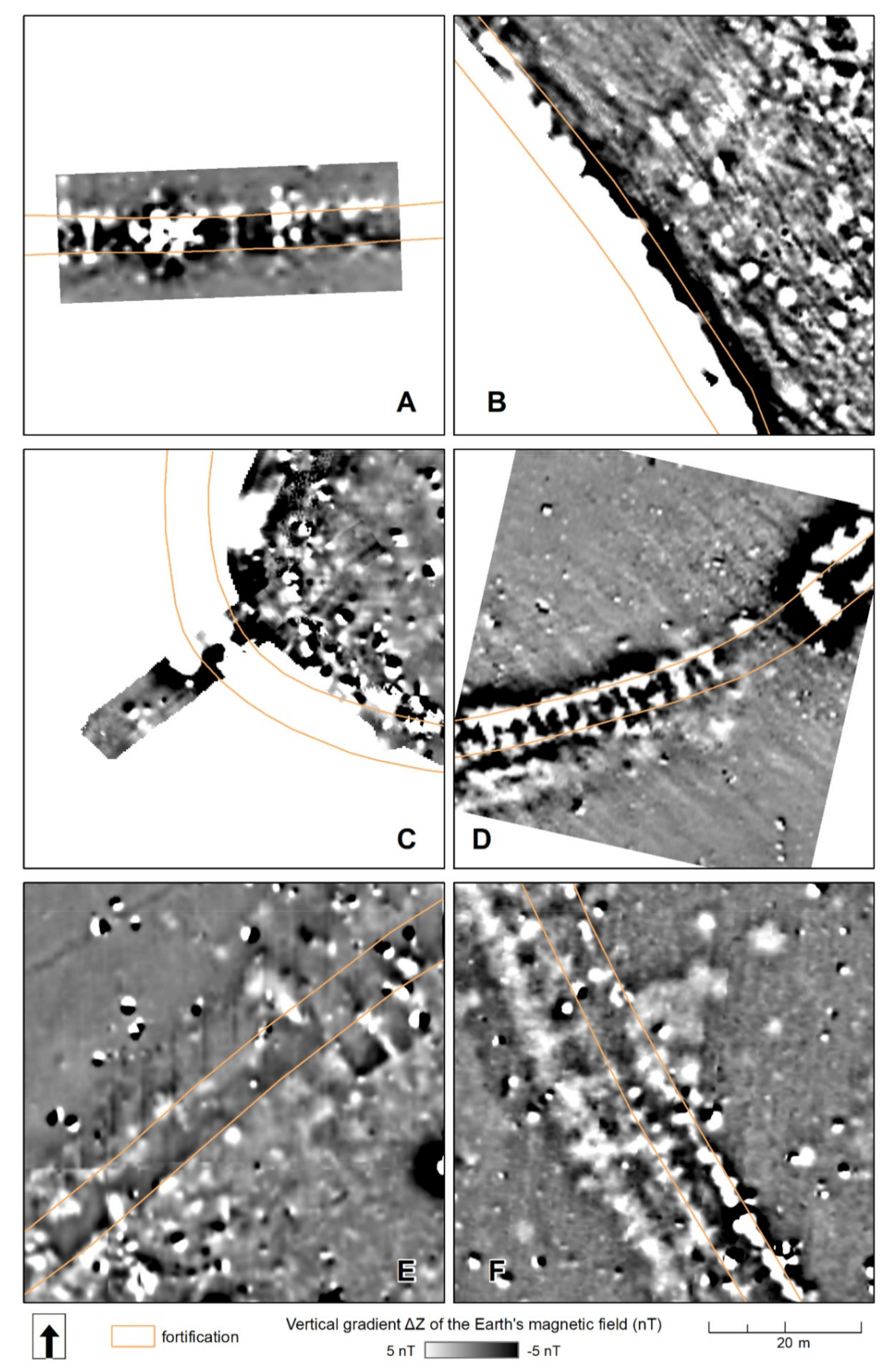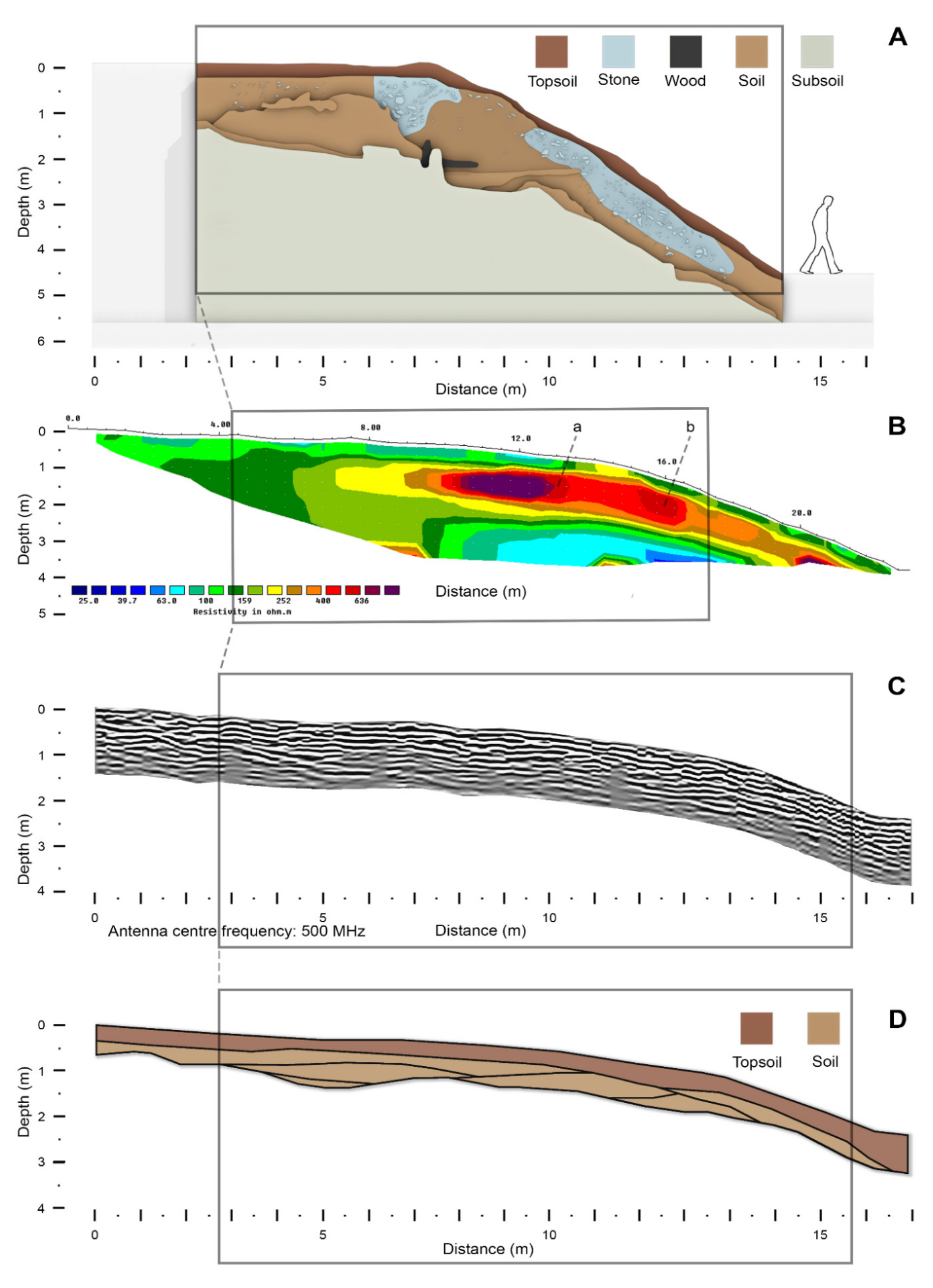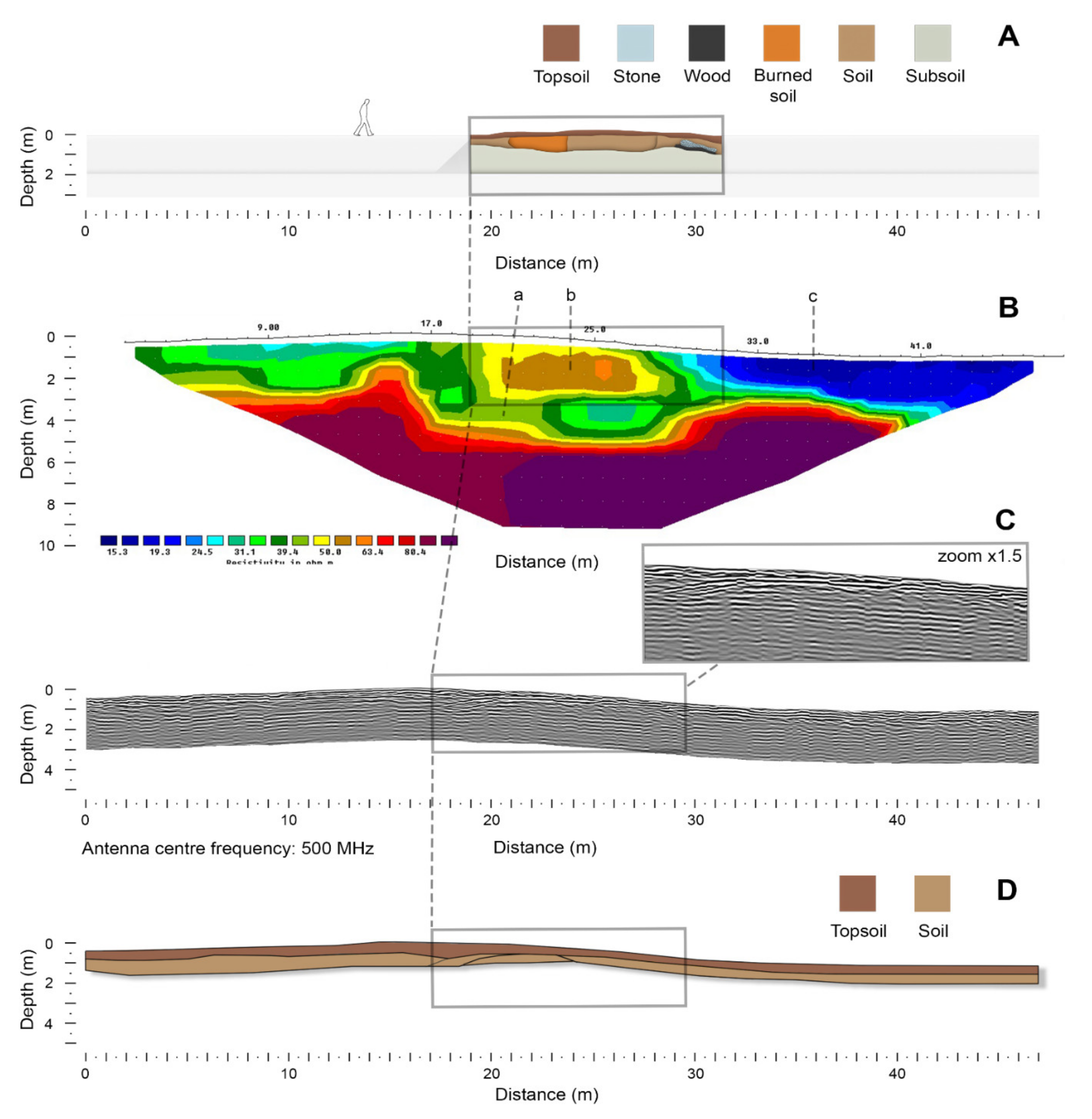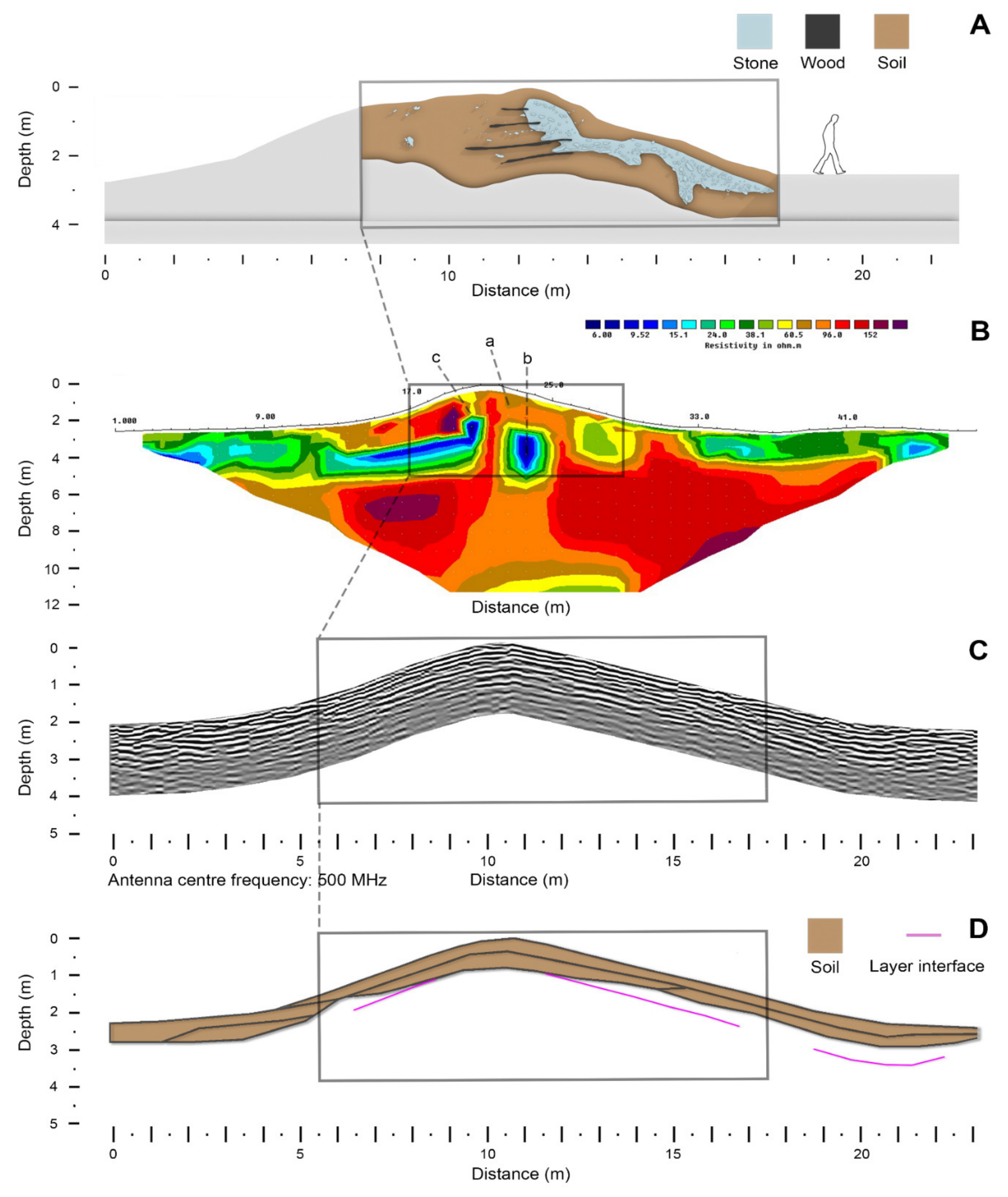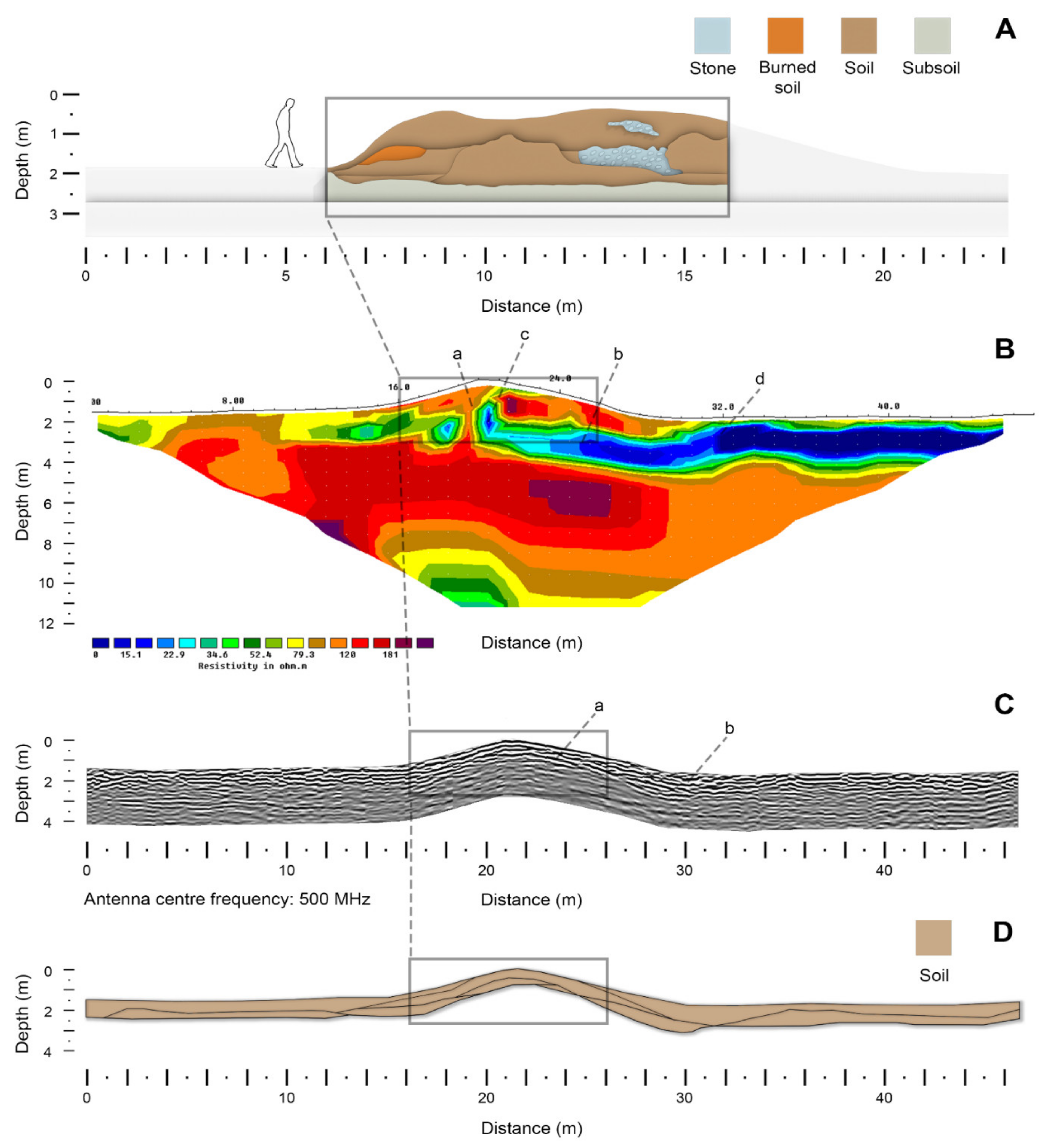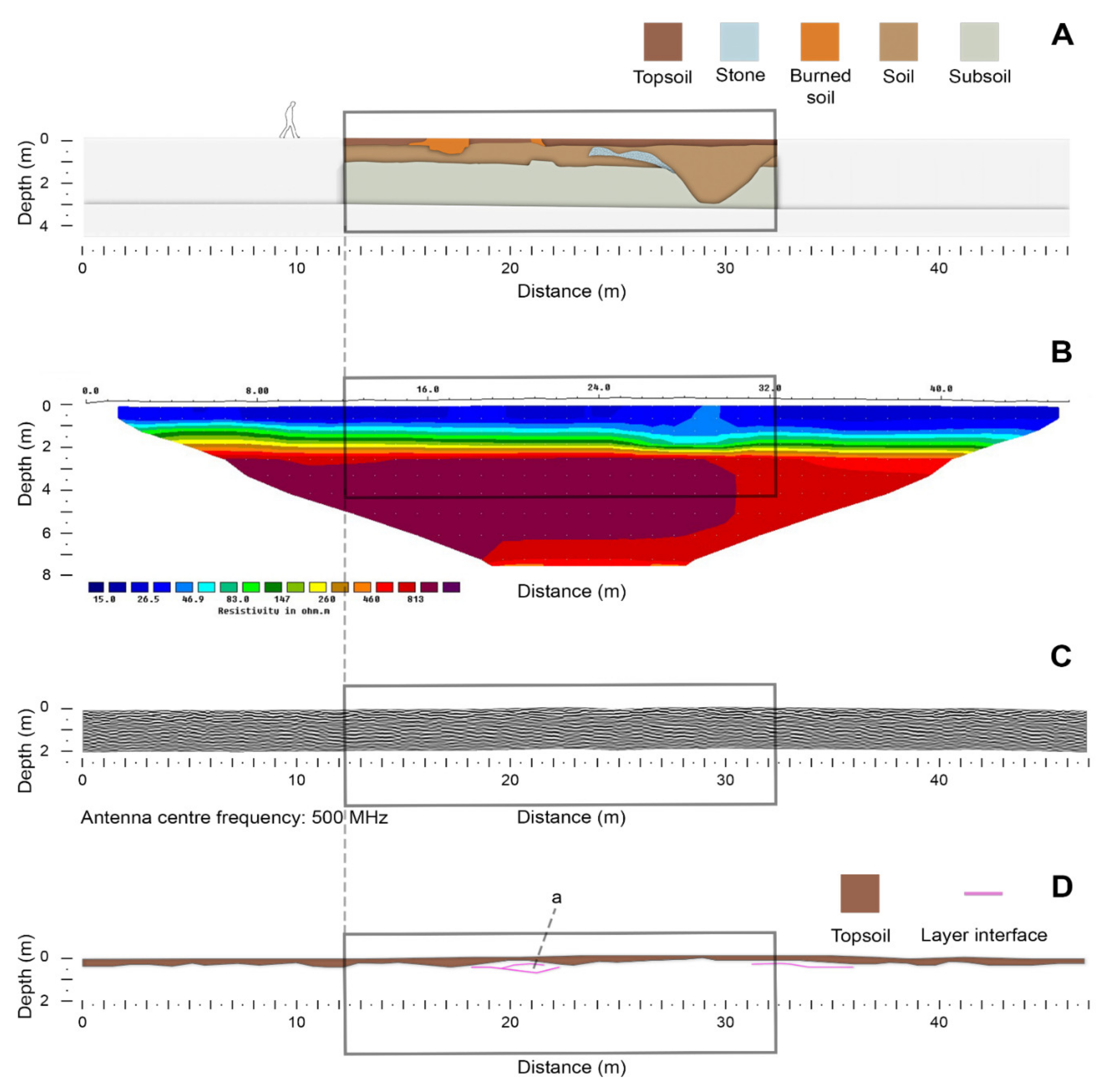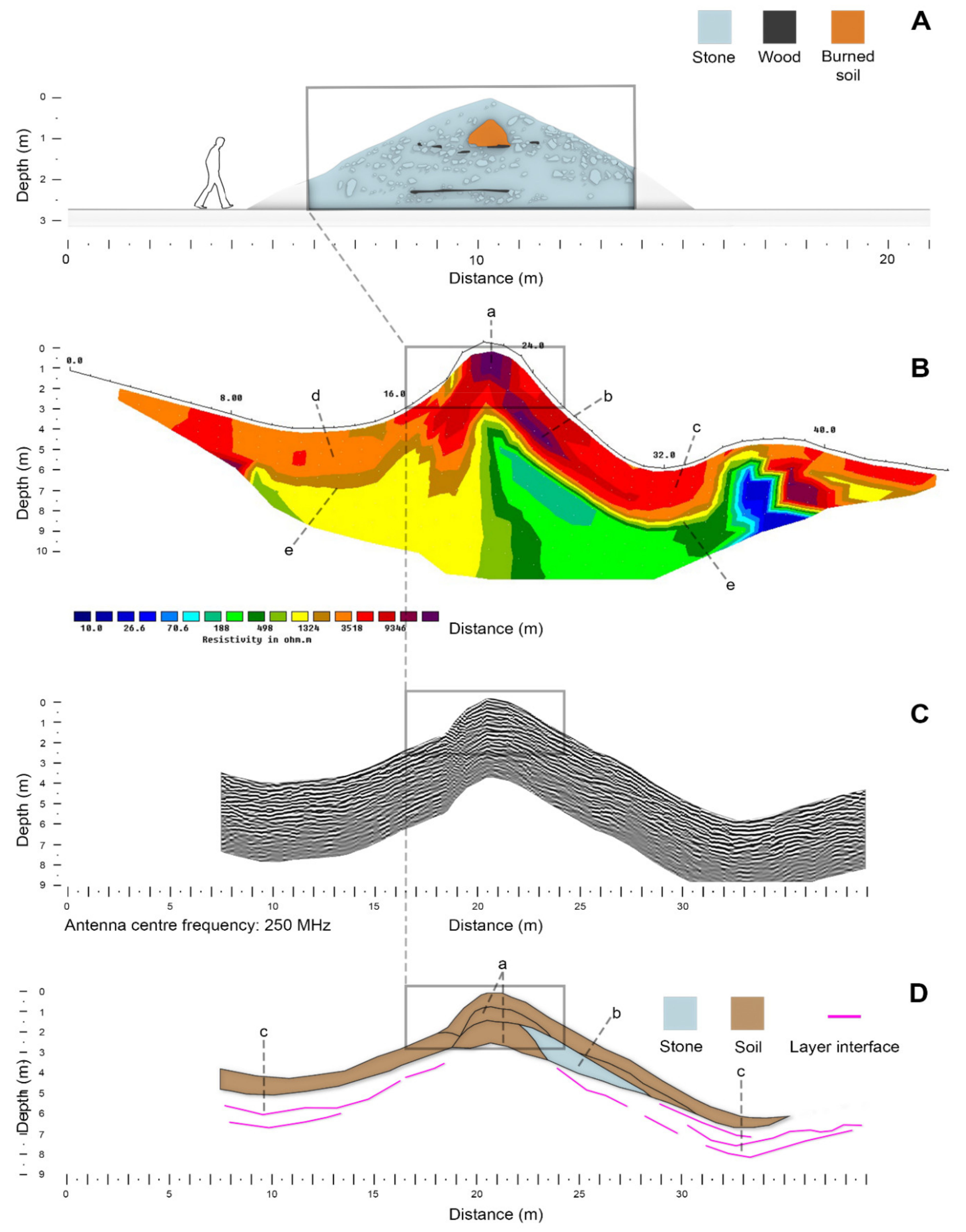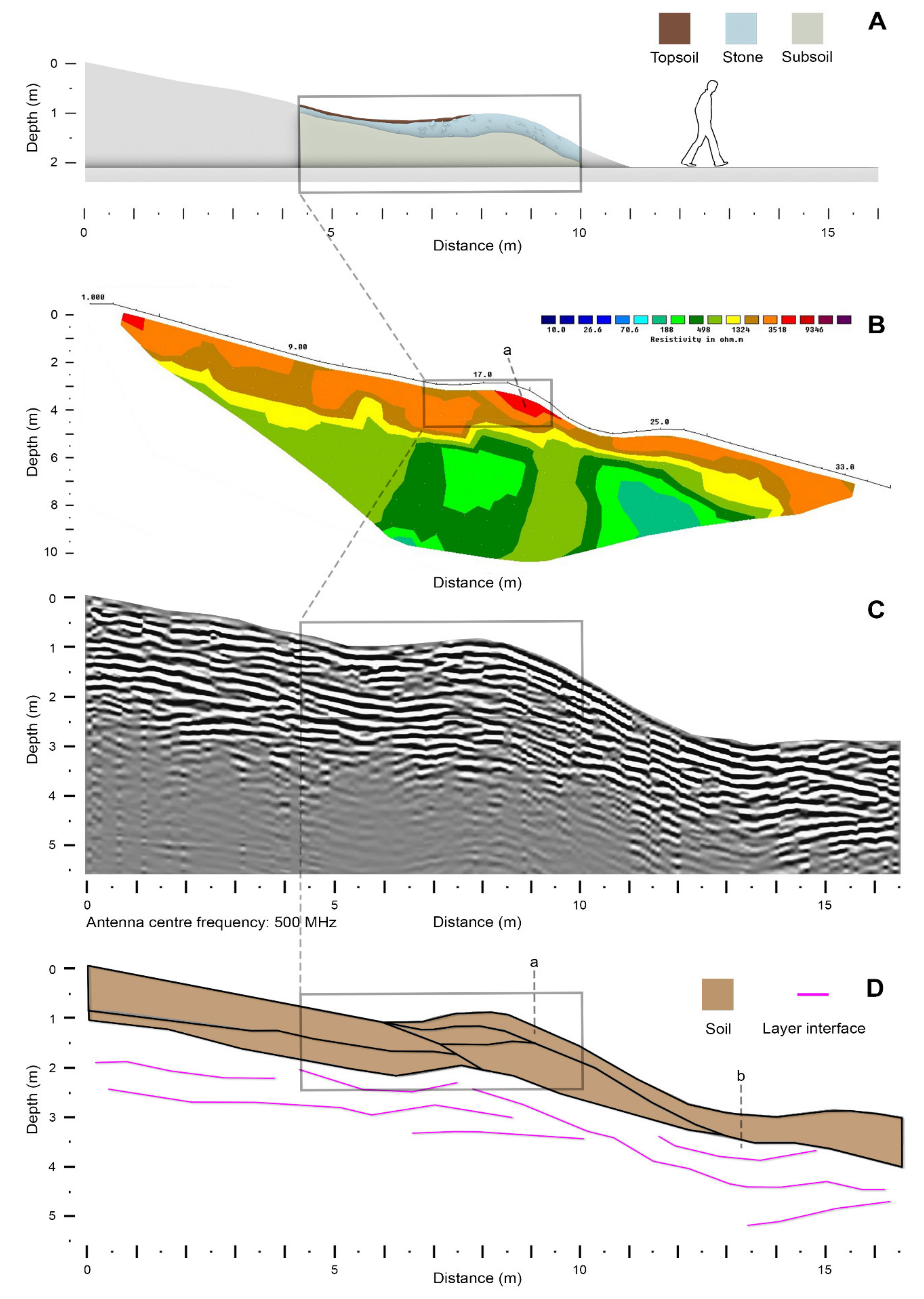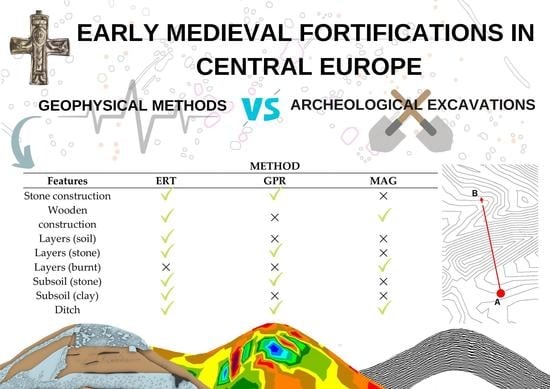1. Introduction
In archaeology, the investigation of fortified sites has a long tradition. Especially in Central Europe, early medieval fortified sites were one of the main topics of archaeological research for several decades. In former Czechoslovakia, they are closely connected with the origin and development of the Great Moravian Empire, which was in the political and scientific circles of the then communist regime, understood as the first common state of Czechs and Slovaks. Therefore, research on the Great Moravian fortifications as centres of power was generously supported financially, launching large-scale field research in the 1950s; which was one of the largest of its time in Europe [
1].
For a long time, a geophysical survey has been a complementary method in the service of archaeological research. However, recent systematic incorporation of archaeogeophysics into several research projects has demonstrated that this method can provide more than just background data for archaeological projects. As a non-destructive approach archaeogeophysics can independently address topics related to the scope, nature, and state of preservation of past anthropogenic activities and remains in the landscape [
2,
3,
4].
Today, we have a large amount of archaeological information regarding early medieval forts. These include data on fortifications, which demonstrate to contemporaries the importance of sites, as well as found evidence of how the structures acted as a defence against enemy forces. Almost all knowledge about the structure of ramparts came from archaeological excavations. So, what kind of new information, as well as additional benefits, can geophysical research bring to this topic? Firstly, it is possible to quickly examine individual segments of fortifications at incomparably low financial costs. Secondly, individual geophysical methods can monitor various physical properties of an investigated structure. We consider that the conclusions we reached in our research are valid for Early Medieval fortifications in the central Danube region and might also be applicable on a broader scale. These research results consist of a combination of wood, earth, stone, and techniques encountered in various parts of Europe from the Bronze Age to the High Middle Ages [
5,
6,
7]. Therefore, our conclusions are valid for the presented sample sites from the Early Medieval times but can find application in different periods and regions where such fortifications occur.
There are two basic models of Early Medieval hillforts based on their position in the landscape: fortified hilltop settlements and fortified settlements situated on slightly elevated places in swampy areas in the floodplains of rivers. We do not know what led the builders to choose the location. Sometimes we find both types of forts close to each other (for example, Ducové and Pobedim in the valley of the river Váh in western Slovakia). The location of the fortified settlements on hilltops or in floodplains depends on environmental parameters, but can also reflect cultural choices ([
8], pp. 63–66). From the point of view of our current research, two preliminary conclusions were drawn, which had to be verified: (i) Hillforts situated in a hilly environment have ramparts rich in stone material, and, at the same time, are relatively well preserved; (ii) On the other hand, hillforts situated in a lowland environment have ramparts that consist mainly of a wood-earth construction with a smaller number of stones. Due to agricultural activity, these sites tend to be, in principle, less preserved.
When classifying early medieval fortifications in Central Europe, we rely on Rudolf Procházka, who distinguishes two basic fortifications: simple and composed of several materials ([
9], pp. 10–18, Figure 1). The first includes a moat, a rampart and a palisade. The second type has a combined wall consisting of wood, earth and sometimes stone elements, which can be interconnected or have various combinations. In the area of interest, we distinguish between the timber-laced and box rampart in terms of the wooden structure of the wall body. The most widespread types were walls with a front stone wall and a rear wooden wall, which were examined, for example, in Mikulčice [
10], Břeclav-Pohansko [
11], Majcichov [
12], as well as in other sites. The widths of the fortifications range from one to nine m. In the case of ramparts with a front stone wall, most cases fit in the range of four to six m. The height of the ramparts ranged between 3.5 to 4.5 m ([
9], p. 263). Today, we find remains of banks at the sites of such fortifications, which are often only a secondary manifestation of the destruction of the original ramparts. It is, therefore, necessary to distinguish between the terms rampart and bank: the first term generally refers to fortifications, while the second term can refer to both the original fortification and the destroyed rampart, which can be observed in the country in the form of a terrain ridge [
13]. The question of how geophysical research can contribute to the knowledge of well or less well preserved remains of early medieval fortifications in the country will be addressed in this studyl generally summarising the results of intensive field research from 2018 to 2020, as well as numerous older findings.
2. Materials and Methods
In the purpose of examining the fortifications of early medieval hillforts by geophysical methods, we selected 10 sites which had been archaeologically studied in the past: Bíňa, Bojná, Břeclav-Pohansko, Brno-Staré Zámky, Dolní Věsonice-Vysoká zahrada, Majcichov, Mikulčice, Nejdek, Pobedim and Svätý Jur-Neštich (
Figure 1,
Table 1). Results of our geophysical prospections on three sites: Brno-Staré Zámky, Dolní Věsonice-Vysoká zahrada and Svätý Jur-Neštich have already been published in detail as case studies [
14,
15,
16]. The remaining sites are presented here for the first time. The sites are situated in mountainous terrain as well as in the valley floodplains of rivers. According to reports from archaeological excavations the fortification walls were built only of earth and wood, as well as stone walls. There are hillforts, having walls which are still well preserved and traceable in the field, as well as hillforts that have been largely destroyed. Our task was to find out how these variable aspects are reflected in the results of individual geophysical methods. We applied three geophysical methods: electrical resistivity tomography (ERT), ground-penetrating radar (GPR), and magnetometry. Each method has its advantages and limitations, depending on the environment and the type of structure examined [
17]. Combining various geophysical methods allows following a broader spectrum of physical properties of individual fortifications. All geophysical surveys were carried out close to areas that have been archaeologically explored in the past (
Figure 2). This fact is an important advantage that enables us to compare the results from the geophysical survey with results from previous archaeological excavations.
2.1. Electrical Resistivity Tomography
The method of electrical resistivity measurement is the oldest geophysical method used in archaeological prospecting. The basic knowledge and procedures developed by geologist Conrad Schlumberger and physicist Frank Wenner in the early twentieth century are still used today [
18]. Since the 1940s, after its first successful application in detecting archaeological structures, it has been used in the entire spectrum of archaeological research [
3,
19]. The electrical resistivity in a rocky environment is influenced by several factors, such as mineralogical composition, porosity, and water saturation. When searching for archaeological objects, the appropriate choice of electrode arrangement is also important. The Wenner, Schlumberger, and double dipole configurations are most commonly used for most archaeological applications [
2,
20]. For deeper research of buried archaeological objects, the application of measurement by electrical resistivity tomography (ERT) is applied [
21,
22,
23]. A large number of electrodes is used in a line to obtain a cross-sectional image in the measured environment when performing ERT measurements. The measurement result is a 2D ERT profile representing the distribution of apparent electrical resistivity (Ωm) on the profile in horizontal and vertical directions [
23,
24].
Electrical resistivity tomography measurements at selected localities were performed with the ARES GF instrument (GF INSTRUMENTS) with a multi-electrode resistivity meter with 48 electrodes. In most cases, the lengths of the measured profiles were 47 m, in some cases 36 m and 73 m long. The spacing between the electrodes was 1 m, in some cases 0.5 m. The ERT survey was conducted in February 2019 at the end of the winter session when the moisture condition of the soil is convenient for the application of this method. All the ERT profiles were oriented outward of the fortified area. The beginning (zero) was always set on the inner side of the fortification. By comparison, measurements were performed in Wenner, Schlumberger and dipole-dipole configurations. The recorded ERT data were processed using the RES2DINV programme (Geotomo Inc., Houston, TX, USA) by applying the robust least-squares optimisation, using the standard least-square inversion methods and finite elements. The measured data were checked, and any extreme values were removed. The measured values of the apparent resistivity were converted to the actual values of the electrical resistivity by inversion. A topographic correction was applied. The final model represents the actual distribution of the measured apparent resistivity on the pseudo section.
2.2. Ground-Penetrating Radar
Ground-penetrating radar has long been one of the most commonly used geophysical methods for identifying subsurface structures in archaeology [
25,
26,
27,
28,
29,
30]. It belongs to the group of active geoelectric or electromagnetic methods. It is based on the repeated transmission of high-frequency electromagnetic pulses (up to 100,000/s) (from 10 MHz to 4 GHz) to the investigated environment and the feedback of their responses. It works on the principle of monitoring changes in physical quantities of the measured environment, i.e., material differences of the subsoil (permittivity) and specific resistances of individual layers (inhomogeneities).
For the GPR survey of the remains of the fortification elements, X3M Ramac georadar (Geoscience AB Malå) and two shielded antennae with a centre frequency of 250 and 500 MHz were used. The measured GPR profiles overlapped ERT profiles and had the same orientations. The interval of measured points was set to 0.1 m. Velocity was set on an average value of 0.1 m/ns suggested by the apparatus manual for unknown conditions. The lines of measurement were always situated perpendicular to the ramparts in the same places as the profiles examined using the ERT method. At all measured profiles, topographic data were collected by a total station at 1 m intervals. The data were processed in Rad Explorer software (Geoscience AB Malå). The standard and generally recommended processing steps were applied: subtraction mean (de-wow) filter, time-zero corrections, bandpass frequency filtering, gain adjustment, background removal and topography correction were calculated on the whole profile length. Bandpass frequency filtering, gain adjustment and background removal settings were chosen according to the needs of the individual case studies, and were adapted to give the best results for each individual measurement.
2.3. Magnetic Survey
Magnetometry is one of the most widely used geophysical methods for detecting and mapping archaeological sites [
17]. Since the late 50s and the successful detection of burned structures in England [
31,
32], magnetometry has become a backbone of archaeogeophysical prospection. Magnetic survey is based on monitoring local variations of the Earth’s magnetic field. These inhomogeneities (magnetic anomalies) are caused by different ratios of ferromagnetic materials in monitored features and enclosing soil matrices [
33,
34,
35,
36]. The contrasts are generally associated with subsurface structures of various, but mainly geological, pedological, or anthropogenic, origins. Human activity in the environment would have caused either material accumulation or magnetisation. The most frequent magnetisation type is thermoremanent magnetisation, during which magnetically weak material becomes strongly magnetic. Based on this effect, archaeological features, such as kilns, ovens, furnaces, or objects filled with burned material, can be detected. The distinction between burned and unburned wall segments was also one of the main tasks of magnetic research.
Magnetic surveys on selected case studies were conducted with several types of magnetometers. Different setups of sensor arrays were implemented, based on the instruments’ availability and accessibility regarding the prospected areas. Surveys in Břeclav-Pohansko were conducted with a caesium magnetometer SM-5 Navmag (SCINTREX) in a vertical gradiometer configuration. The spatial resolution of collected data was 1 m (transect separation) by approximately 0.25 m (in-line). Magnetometers with three up to ten Ferex CON650 (FOERSTER) probes were used at the remaining locations. The horizontal separation of the probes was set up to 0.5 m. Data were collected every 0.25 m along with each measured profile. Data were processed and gridded in Eastern Atlas LEAD2 software or using the in-house developed script and Surfer 7 (Golden Software). Raw data were normalised with a median filter and drift correction was performed. Results of every magnetometry survey were interpolated in a 0.25 × 0.25 m raster. Interpretation and final visualisation were produced in ArcGIS 10.7 (ESRI).
4. Discussion
The range of basic geophysical measurements, which were used for the first time to such an extent to solve the specific archaeological problems of the early medieval ramparts, offers many topics for discussion. Although we work with physically measurable quantities and the results of measurements can be expressed in the form of precisely defined values, factors such as short-term or long-term climatic conditions significantly affect the final interpretation [
49,
50,
51], as well as the experience and knowledge of the surveyor [
4,
35], or the instruments and software used [
52,
53]. Archaeological interpretation of geophysical data is therefore never entirely objective. Nevertheless, given the quantity of available data, it is possible to monitor trends that could be described as generally valid (
Table 2).
In determining the materials of which the examined ramparts consist, ERT was the most effective of all three methods implemented. The recorded results of ERT measurements often offer a surprisingly detailed picture of the internal structure of the rampart and ditch fillings. The measured values of the ERT data reflected the type of construction material used, which depended on local resources. There is apparent difference between fortified hillfort and lowland settlements. Based on the electrical resistivity values (1000 Ωm and more), the stone features of the ramparts were clearly recognisable. The largest share of the stone component is shown by the remains of the fortifications at the Svätý Jur—Neštich (
Figure 13B) and Bojná (
Figure 4B) hillforts. Both sites are located in a mountainous environment; therefore, the stone did not have to be imported. During the process of digging a ditch, a large amount of stone was mined, which was subsequently used not only for building the front wall but also as a filling of the rampart’s bodies. In particular, the Neštich hillfort is an excellent example, with a compact structure in the central part and on the front side of the rampart, which is a manifestation of the rich representation of stone rubble in the filling of the rampart’s body and the destruction layer coming out from the front stone wall. The ERT measurements at both sites fully correspond to the results of archaeological research ([
38], pp. 20–23, [
54], pp. 70–91). The ability of ERT to detect frontal stone walls in ramparts with wooden structures filled with soil can also be described as successful. In accordance with the results of archaeological excavations ([
10], pp. 128–131, [
11]), the remains of the frontal stone walls were identified based on higher values of electrical resistance (approx. 300 Ωm—in comparison with the surroundings, characterised by values of approx. 30 to 50 Ωm) and their destruction layers at the hillforts of Břeclav-Pohansko (
Figure 5B) and Mikulčice (
Figure 10B).
GPR is generally considered an ideal method for detecting stone structures [
26,
27,
28]. In this case, we assumed its high informative value in identifying the stone features of the ramparts. However, the reality was different. The results of GPR surveys did not provide as differentiated an image of the internal structure of the ramparts as we expected. Numerous inhomogeneities, proving a high proportion of stone, were observed at the site of Svätý Jur—Neštich (
Figure 13C,D) and Bojná (
Figure 4C,D). Also, on the radarograms ditch fillings that contained stone material were quite visible. However, the distinction of individual archaeological structures from the geological subsoil was relatively complicated at both sites. Nevertheless, it was impossible to fully distinguish the stone component even in Břeclav-Pohansko (
Figure 5C,D) and Mikulčice (
Figure 10C,D), where the front walls and their destruction are surrounded mainly by clay backfill.
The magnetic survey recorded zero success in detecting stone elements of fortifications. It should be noted that the magnetic survey was only marginally done on the sites with stone-rich ramparts, such as Bojná and Svätý Jur—Neštich. The front stone wall could not be detected anywhere—not even on the sites where it is well preserved, such as in Břeclav-Pohansko (
Figure 6A). The reason is the character of the material used for construction. In our conditions, it is limestone, which does not differ significantly from its surrounding magnetic values. Usually, objects built of limestone appear as magnetically negative structures. However, this is not the case with the examined early medieval ramparts. This phenomenon occurs due to the stone walls being significantly destroyed, and even in cases where their parts are intact, they are surrounded by destroyed clay-stone layers. The same results have been reached in the surrounding regions [
55,
56].
Geophysical methods also point to differences in the ramparts’ soil composition, particularly in the results of the GPR surveys, which indicates two indistinct layers in otherwise homogenous radarograms. The differences in soil composition in the results of ERT measurements are most significant. For example, in the remains of ramparts in Bíňa (
Figure 3B) and Dolní Věstonice (
Figure 8B), it was possible to distinguish the humus layers from the loess layers or the sandy outer layer from the clay core. In Bíňa, it was also possible to rule out the occurrence of stone in the backfill. Magnetic research has not brought new knowledge to this issue.
An essential structural element of fortifications is their wooden features in the form of log boxes or gratings. Their detection by GPR or ERT is problematic due to the poor state of their preservation. Their presence can only be demonstrated indirectly. Anomalous zones point them out with low values of electrical resistivity, related to the fillings of wooden structures—observed in Bojná, Dolní Věstonice, Majcichov, Nejdek, and Svätý Jur. However, it should be emphasised that our interpretation of geophysical data would not be so clear without knowing of the presence of wooden structural elements in the ramparts.
The best results were obtained by magnetometry, especially in ramparts where wooden structures were located near the surface. The existence of a rear supporting wooden wall of the rampart was found in Břeclav-Pohansko (
Figure 6A). It was well detected in the data because the wall burned down. Several significant magnetic anomalies were also located here, reaching values above 250 nT/m. We can follow traces of fire here, which engulfed the original wood-clay rampart in the given segments. Archaeological research also documented wooden tunnels inside the rampart to ascend to the gallery ([
11], pp. 104–106; Figures 117–121). Interestingly, such anomalies occur at regular 15 to 20 m intervals on the magnetic map. Therefore, we can assume that these are evenly spaced wooden reinforcements of the tunnel system.
Since the fortification burned down, the wooden chamber construction excelled with its high magnetic values (10–300 nT/m) in Majcichov (
Figure 6D) and Pobedim (
Figure 6F). Interestingly, in some sections of these two hillforts, it was possible to distinguish individual wooden boxes, even in the unburned parts of the rampart. We can observe very weak negative anomalies in the magnetic data, interpreted as the front and rear walls and partitions of wooden boxes. The ramparts did not burn here, and the inner wooden box structures, and the soil with which the boxes were filled, were not permanently magnetised. The opposite effect was observed with the parts of the rampart that were subject to fire. The wooden structures here gradually fell apart. The clay material used to build the rampart and the filling of wooden boxes naturally show slightly higher magnetic values than the wooden parts of the fortification. These can then be observed as slightly negative anomalies (−0.1 nT/m). In both cases, the survey results coincide with the findings of previous archaeological research [
12,
46].
From geophysical data, we can determine one way the functionality of the ramparts was extinguished, even in cases where the fortification burns down. As mentioned above, traces of an intense fire in the wooden structures of the ramparts were detected in several investigated sites (Břeclav-Pohansko, Majcichov, Pobedim). Traces of fire in the form of burnt wood-clay banks (Bojná, Brno-Staré Zámky, Dolní Věstonice) were also registered on other sites. It turns out that destructive flames affected most of the early medieval hillforts in the central Danube region. This finding confirms and expands existing knowledge from archaeological research [
57]. At the same time, it has been shown that magnetometry can provide the best indications for research into this phenomenon.
The natural environment and terrain conditions are important factors in assessing the results of geophysical surveys. Individual methods can be challenged by the conditions of forest versus open landscape. The advantage of open terrain applies to all methods. The electrical method has the smallest deficit in the forest environment, while dense growth is an obstacle in geo-radar survey and magnetometry. The same conclusion applies when taking into account complex topographic relief. While in the magnetic and geo-radar survey inaccuracies in the measurement results must be taken into account, despite postprocessing of the data, in ERT, this phenomenon did not manifest itself, due to the secondary application of field corrections (this is especially true for measurements with Wenner and Schlumberger configurations).
The rock character of the subsoil and the material composition of the rampart has a more significant influence, than the character of terrain, on measurement results [
2,
58]. The most suitable measuring media for ERT and GPR methods is generally composed of contrasting and well-distinguishable materials. In the survey of early medieval hillforts, it was possible to apply these methods well to those ramparts for which stone was used as one of the building materials. Thanks to its different physical properties, it can be well distinguished from the surrounding clay soils. In these cases, it is mainly a matter of detecting the destruction of front stone walls. In our case, the magnetometric measurements were not significantly affected by the rocky environment. However, in the lowlands, where the environment is composed of river sediments, the sections of the ramparts (untouched by fire) are less pronounced than in sites located in higher positions, where the ramparts are made of more magnetic rock materials.
The informative value of the geophysical survey significantly depends on the preservation of the fortification, which is closely linked to the location of the site and the activities that took place on it. The state of preservation of the fortifications is most reflected in long-term intensive agricultural activity, which in most cases is mainly related to sites in the lowlands. The destructive layers have a negative effect on the readability of the data, especially in GPR surveys. On the contrary, magnetometry can benefit from poor rampart preservation. For example, on relatively intact ramparts, it is impossible to monitor the ramparts’ internal structures in detail, and definitely not as much as is possible on the largely ploughed and surface-exposed structures in the Majcichov and Pobedim sites. Even though it was not the task of the presented research, we can say in general that the main advantages of magnetometry include the ability to quickly and accurately detect invisible, or hard to recognise, fortifications in the field, such as palisade troughs, clogged ditches, or wholly destroyed ramparts. On the contrary, the geophysical survey contributes to important findings concerning preservation of the fortifications on individual sections of the ramparts. This plays a vital role in planning field archaeological work or monument conservation cases [
59].
An important parameter in any survey is the correctly chosen methodology. The methodology chosen by us has its weaknesses in evaluating and comparing the obtained data. We relied on surveys based on individual profiles with ERT and GPR methods, but it would be more appropriate to focus on surveys based on whole areas. However, due to the dense vegetation and challenging terrain, such surveys could not be carried out in most of the studied sites. Despite the chosen methodology, both methods enabled vertical penetration into the ramparts’ cores and, in comparison with magnetometry, brought a whole range of information. On the contrary, magnetometry proved to be highly effective in area measurements, where it was possible to observe spatial relationships at the horizontal level.
Regarding the complexity of measurements and the financial and time factors, what type of method should be implement in the case of research into early medieval fortifications in the future? A straightforward answer to such a question cannot be given. It always depends on many variables, among other things on research tasks, state of sites, and parameters of the available technical equipment. However, we have concluded that ERT appears to be the optimal method for well-preserved remains of fortifications. Thus, we were able to record situations (layers and destructions inside the bodies of the ramparts, the level of the subsoil, ditches) in all surveyed sites, which corresponded to the findings from archaeological excavations. The GPR survey—especially by individual profiles—is more time-saving in the preparation and measurement process. While it takes a few minutes to measure one GPR profile, it takes approximately one hour to measure one ERT profile. However, the interpretation of the GPR data turned out to be significantly more complicated and, at the same time, less convincing. The advantage of magnetometry is less complexity in performing measurements and interpreting data. However, magnetometry did not provide any essential information, other than the ability to identify burnt-out parts of the ramparts on well-preserved ramparts.
On the contrary, with significantly levelled fortifications, it was possible to record the internal wooden structures on the unburned parts by magnetometry. However, it was possible to reach the given results only by areal magnetometric surveys. Last but not least, the possibility of potential contamination of the investigated areas with recent disturbing elements should be mentioned. These can negatively affect the magnetic survey results, as was the case, for example, at the Bíňa fortified settlement. In such cases, ERT and geo-radar surveys are less affected by the environment. Therefore, if possible, it is advisable to use a combination of at least two methods.
5. Conclusions
Ten early medieval hillforts were selected to examine fortifications by geophysical survey. Three of the most used methods in archaeogeophysics were applied: electrical resistivity tomography (ERT), ground-penetrating radar (GPR), and magnetometry. Overall, we can say that the range of results achieved on individual ramparts is well above expectations. Several structural features were identified in detail in several ramparts by combining individual methods.
The ERT method documented numerous inhomogeneities at individual fortifications, which point to different construction materials, different intensities of their use, and the state of preservation of the ramparts. In several cases, it was possible to determine the original levels of the terrain, the stone and clay cores of the ramparts, and the extent of the destruction of the stone walls.
The GPR method is generally suitable for identifying stone structures and determining different materials and layers. Nevertheless, a survey of the early medieval ramparts did not yield the expected results. With a high degree of reliability, it was possible to identify ditches and their differentiated backfill. Some structural features inside the ramparts, especially their stone parts, were only identified thanks to our knowledge of specific situations from past archaeological excavations.
Magnetometry has proven to be an ideal method for researching fortifications preserved by torsion. Here, it was mainly possible to identify the wooden parts of the walls and identify the areas affected by fire.
The results of the performed geophysical surveys have not been verified by archaeological research. Nevertheless, we consider our interpretations to be highly credible. All surveys were carried out in the vicinity of past archaeological excavations. Geophysics and archaeology could therefore be directly confronted and compared. Another important fact is that the conclusions we reached in our research are not only valid for early medieval fortifications in the central Danube region. Fortifications built with a combination of wood, earth, and stone represent a supra-regional phenomenon, evidenced in different periods. Therefore, the findings presented in this study can be used to study a wide range of fortifications, taking into account local conditions.
